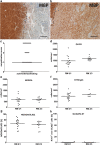Lesion stage-dependent causes for impaired remyelination in MS
- PMID: 32710244
- PMCID: PMC7424408
- DOI: 10.1007/s00401-020-02189-9
Lesion stage-dependent causes for impaired remyelination in MS
Abstract
Multiple sclerosis (MS) is the most frequent demyelinating disease and a leading cause for disability in young adults. Despite significant advances in immunotherapies in recent years, disease progression still cannot be prevented. Remyelination, meaning the formation of new myelin sheaths after a demyelinating event, can fail in MS lesions. Impaired differentiation of progenitor cells into myelinating oligodendrocytes may contribute to remyelination failure and, therefore, the development of pharmacological approaches which promote oligodendroglial differentiation and by that remyelination, represents a promising new treatment approach. However, this generally accepted concept has been challenged recently. To further understand mechanisms contributing to remyelination failure in MS, we combined detailed histological analyses assessing oligodendroglial cell numbers, presence of remyelination as well as the inflammatory environment in different MS lesion types in white matter with in vitro experiments using induced-pluripotent stem cell (iPSC)-derived oligodendrocytes (hiOL) and supernatants from polarized human microglia. Our findings suggest that there are multiple reasons for remyelination failure in MS which are dependent on lesion stage. These include lack of myelin sheath formation despite the presence of mature oligodendrocytes in a subset of active lesions as well as oligodendroglial loss and a hostile tissue environment in mixed active/inactive lesions. Therefore, we conclude that better in vivo and in vitro models which mimic the pathological hallmarks of the different MS lesion types are required for the successful development of remyelination promoting drugs.
Keywords: Microglia; Multiple sclerosis; Oligodendrocytes; Remyelination.
Conflict of interest statement
T.K. has a pending patent application for the generation of human oligodendrocytes.
Figures







Similar articles
-
Extrinsic immune cell-derived, but not intrinsic oligodendroglial factors contribute to oligodendroglial differentiation block in multiple sclerosis.Acta Neuropathol. 2020 Nov;140(5):715-736. doi: 10.1007/s00401-020-02217-8. Epub 2020 Sep 7. Acta Neuropathol. 2020. PMID: 32894330 Free PMC article.
-
Oligodendroglial lineage cells express nuclear p57kip2 in multiple sclerosis lesions.Glia. 2013 Aug;61(8):1250-60. doi: 10.1002/glia.22512. Epub 2013 Jul 5. Glia. 2013. PMID: 23828667
-
Limited TCF7L2 expression in MS lesions.PLoS One. 2013 Aug 20;8(8):e72822. doi: 10.1371/journal.pone.0072822. eCollection 2013. PLoS One. 2013. PMID: 23977356 Free PMC article.
-
The Molecular Basis for Remyelination Failure in Multiple Sclerosis.Cells. 2019 Aug 3;8(8):825. doi: 10.3390/cells8080825. Cells. 2019. PMID: 31382620 Free PMC article. Review.
-
The role of oligodendrocytes and oligodendrocyte progenitors in CNS remyelination.Adv Exp Med Biol. 1999;468:183-97. doi: 10.1007/978-1-4615-4685-6_15. Adv Exp Med Biol. 1999. PMID: 10635029 Review.
Cited by
-
Chronic oligodendrocyte injury in central nervous system pathologies.Commun Biol. 2022 Nov 19;5(1):1274. doi: 10.1038/s42003-022-04248-1. Commun Biol. 2022. PMID: 36402839 Free PMC article. Review.
-
Failed remyelination of the nonhuman primate optic nerve leads to axon degeneration, retinal damages, and visual dysfunction.Proc Natl Acad Sci U S A. 2022 Mar 8;119(10):e2115973119. doi: 10.1073/pnas.2115973119. Epub 2022 Mar 2. Proc Natl Acad Sci U S A. 2022. PMID: 35235463 Free PMC article.
-
Pinocembrin Promotes OPC Differentiation and Remyelination via the mTOR Signaling Pathway.Neurosci Bull. 2021 Sep;37(9):1314-1324. doi: 10.1007/s12264-021-00696-7. Epub 2021 Jun 6. Neurosci Bull. 2021. PMID: 34091810 Free PMC article.
-
Regulation of stress granule formation in human oligodendrocytes.Nat Commun. 2024 Feb 19;15(1):1524. doi: 10.1038/s41467-024-45746-6. Nat Commun. 2024. PMID: 38374028 Free PMC article.
-
Central nervous system macrophages in progressive multiple sclerosis: relationship to neurodegeneration and therapeutics.J Neuroinflammation. 2022 Feb 10;19(1):45. doi: 10.1186/s12974-022-02408-y. J Neuroinflammation. 2022. PMID: 35144628 Free PMC article. Review.
References
Publication types
MeSH terms
LinkOut - more resources
Full Text Sources

